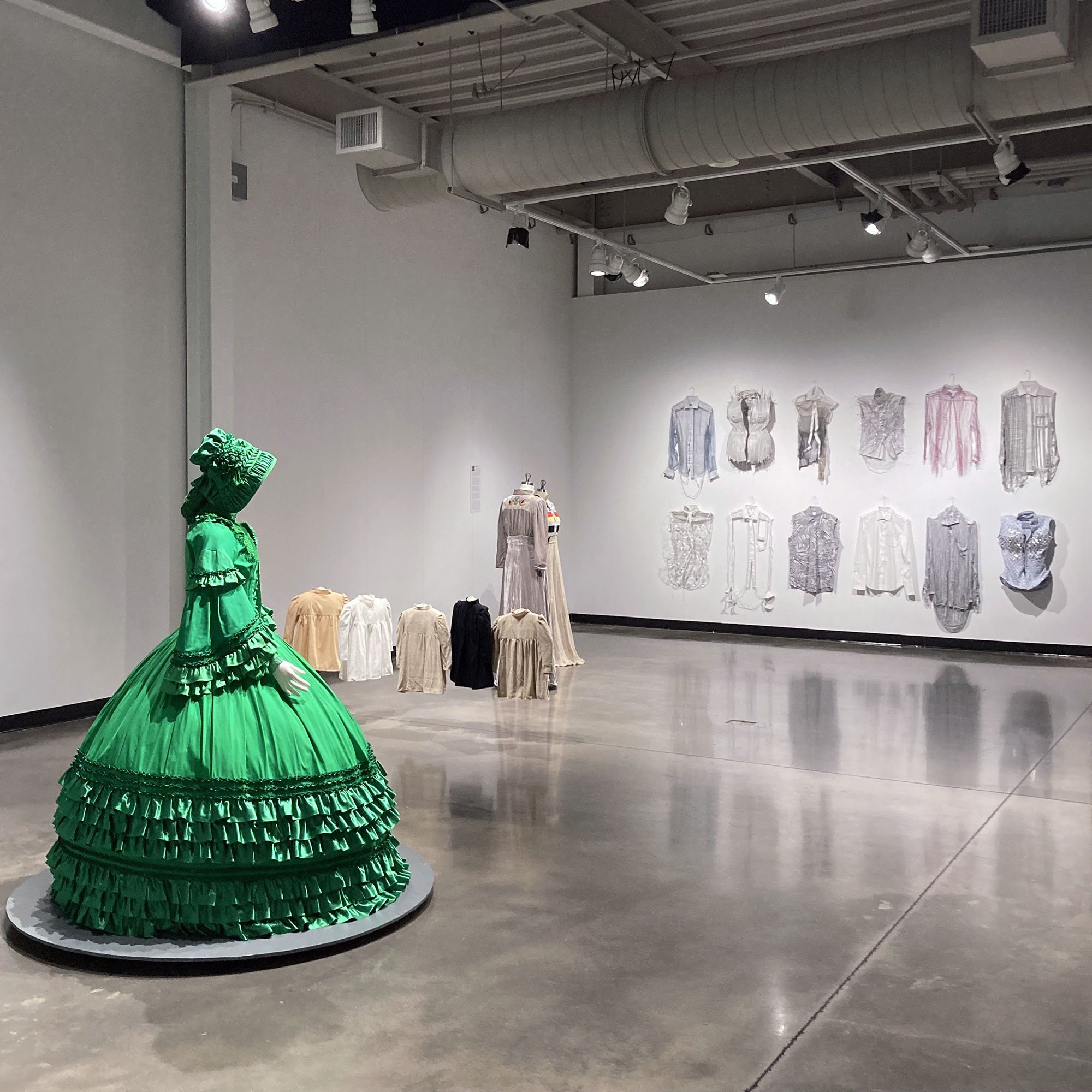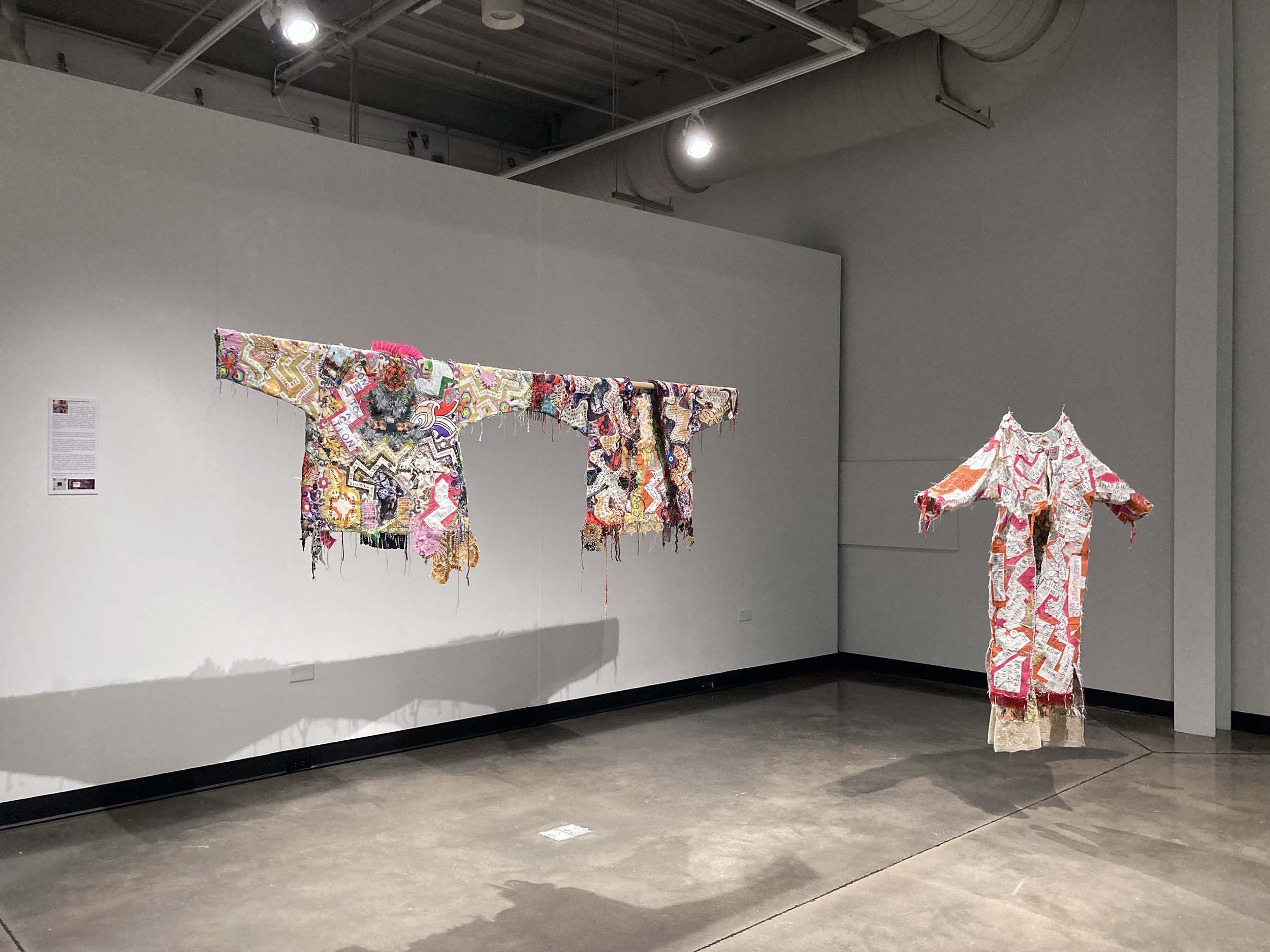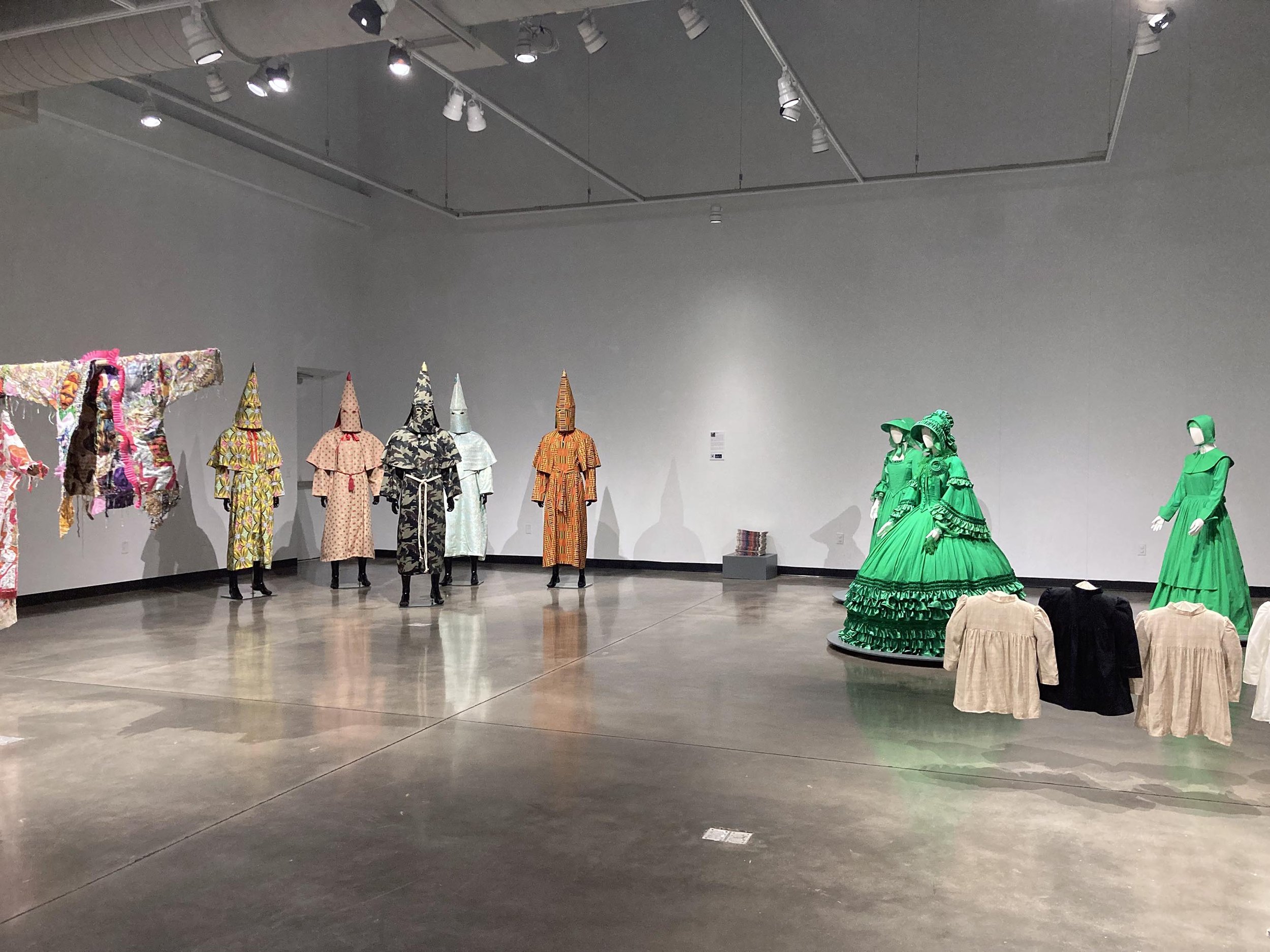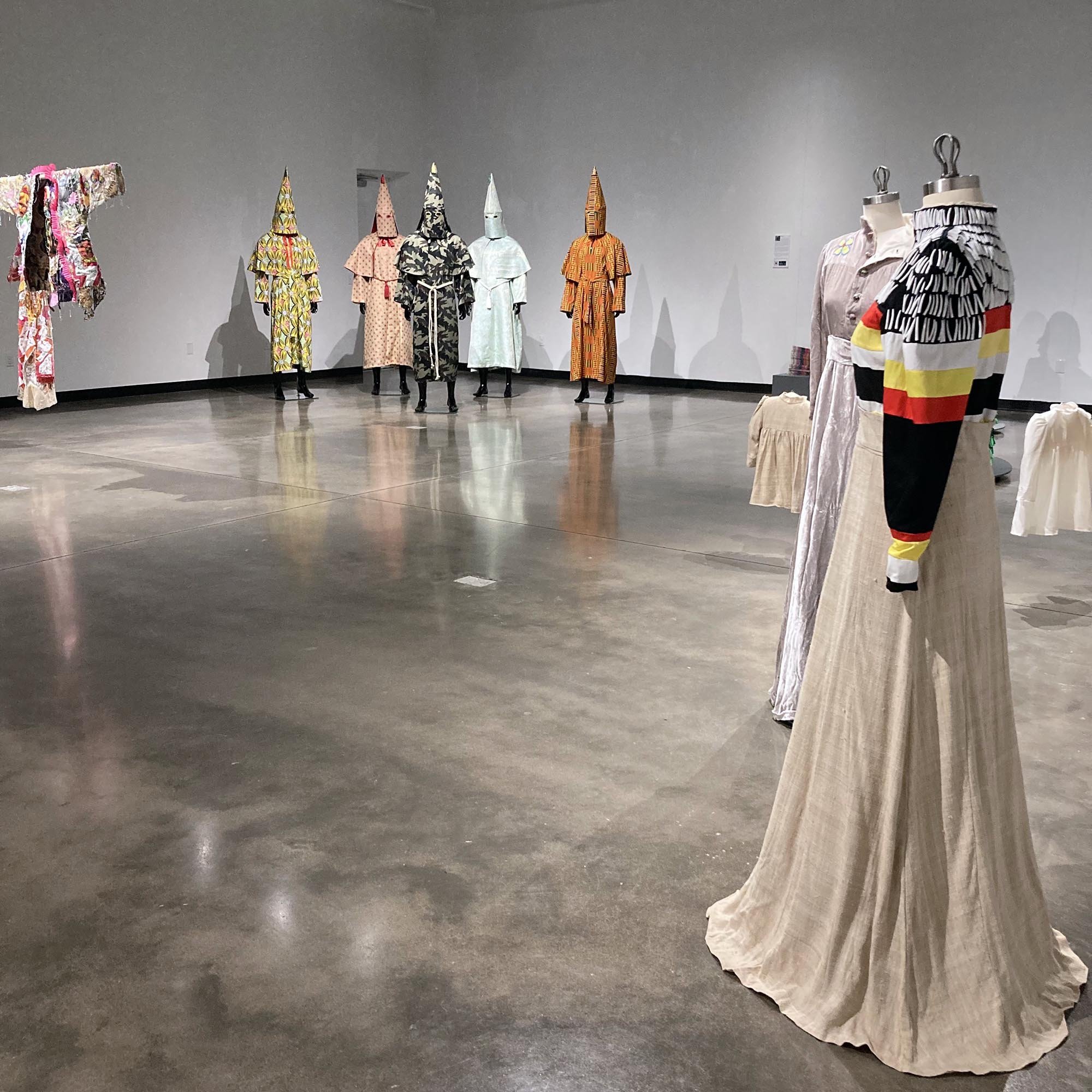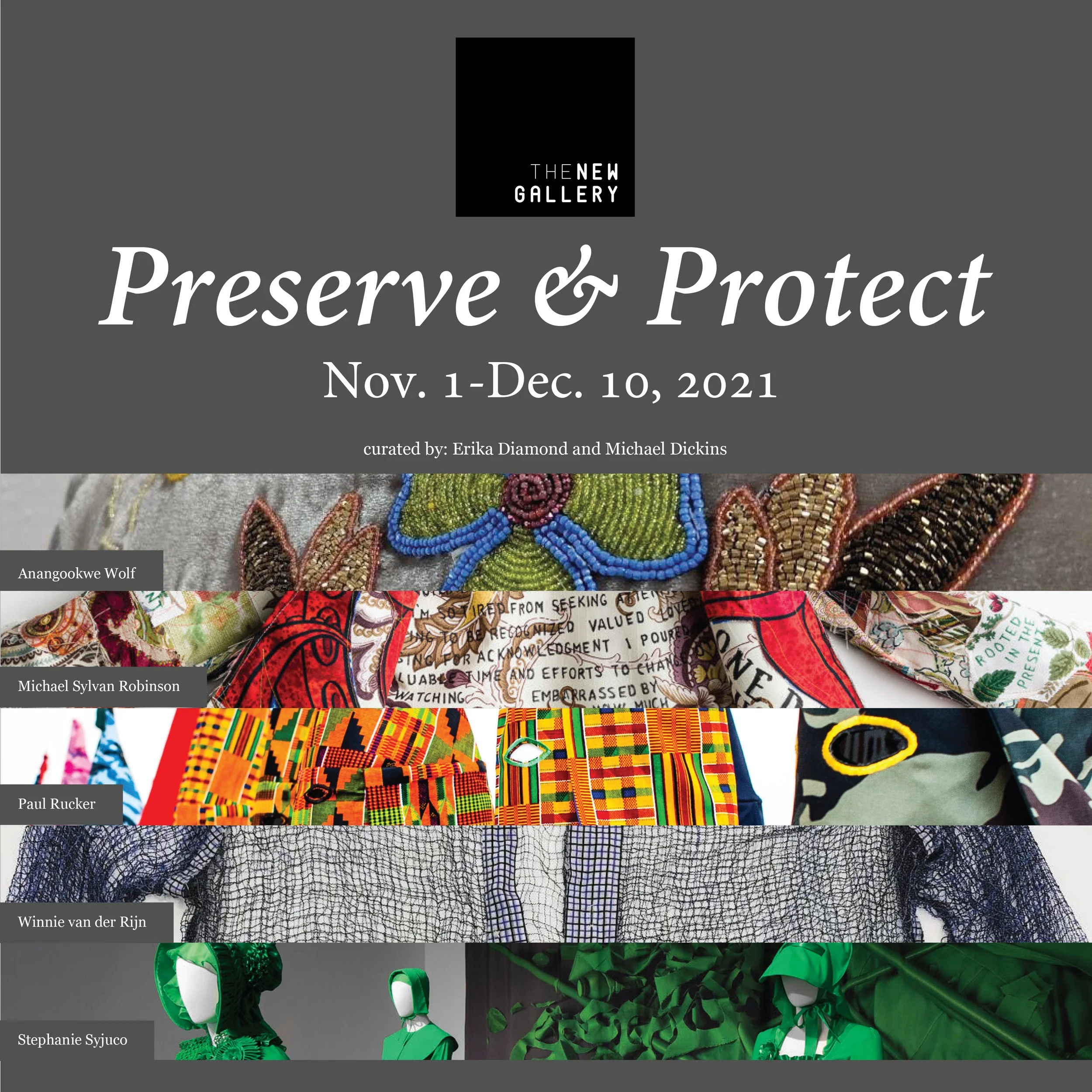Anangookwe Wolf, “The Matriarchs (Phillipena and Mary)”
Preserve & Protect
New Gallery, Austin Peay State University
November 1 - December 10, 2021
Co-curated with Michael Dickins
Textiles serve to protect us, to tell our stories, and to display our privilege. This exhibition of conceptual garment work looks at the complex ways in which textiles, particularly garments, tell the stories of the past, present, and future. More than just armor for the body, they relay the resilience of a culture - worn for protection but also as a way to assert one's identity. The works of Michael Sylvan Robinson, Paul Rucker, Stephanie Syjuco, Winnie van der Rijn, and Anangookwe Wolf bear witness to and challenge our shared American history. They question whose histories have had the privilege of being heard and ask for a more inclusive authorship of our shared history.
Through recognizable structures in historical fashion and strategic embellishments, the textiles in this exhibition recontextualize and assert shrouded histories. They affirm the value of lives lost due to persistent ideals of colonialism, bigotry, and unequal power structures. They reveal concurrent histories and ask for better futures. They show that garments have the power to express and reclaim our personal and cultural histories.
Excerpts from Curatorial Essay:
The notion of a shared history is alluring, but our stories are penned by authors from different perspectives with varying degrees of access to the stage, the pulpit, the megaphone, or perhaps most importantly, the school. Some histories have been historically muted and are only beginning to be heard by a wider audience. Clothing conceals our bodies, but it also reveals many aspects of who we are. Certain embellishments provide clues as to our cultural background, while uniforms mark our trades and allegiances. At a glance, T-shirts and hats bear slogans, bandanas in various colors share queer secrets, and certain prints or patterns reveal everything from a person’s heritage to their recent travel history. These wearable markers offer quick glimpses into our identities and ideologies. Our bodies are a canvas for propaganda.
Honoring her ancestors, the dresses of Anangookwe Wolf tell the story of her two great grandmothers, the Matriarchs, Mary Wolf of Ojibwe and German descent and Phillipenna McClanny of Assiniboine descent. Phillipenna is constructed in a typical Victorian fashion as a recreation of her great grandmother’s Indian boarding school uniform, while the reverse side is colorfully embellished in their traditional Assiniboine style using dentalium shells. It reveals the parts of Phillipenna’s heritage that were kept hidden but held close and still preserved, celebrated now by her descendant Anangookwe. By embellishing these dresses with cultural signifiers from traditional indigenous clothing, these garments act as a way to preserve and protect Wolf’s heritage.
Garments, as uniforms, have the ability to reveal our social networks and signal our allegiances. One of the most destructive examples of this power of the cloth are the white hooded robes worn since the 1860’s by the white supremacist terrorist group the Ku Klux Klan, both as a method of intimidation and a way to evade accountability. Paul Rucker subverts the power of this symbol with his series of 80 hooded robes in “Storm in the Time of Shelter”, reclaiming the 1920’s design of the Ku Klux Klan robe through the use of different fabrics, including camouflage, polka dots, and Kente cloth. Especially through the use of camouflage fabric, Rucker’s robes allude to the stealth aspect of racism, but they are indeed meant to provoke. Dress it up any way you want, racism is a contemporary American issue, and not a thing of the past. Rucker believes that once we acknowledge and confront the legacy of slavery, only then we will have the collective power to dismantle it.
Winnie van der Rijn strips, unweaves, dyes, and in other ways dismantles the mundane collared shirts that are meant to represent the American Patriarchy. Her interventions upon menswear are both gestural and methodical, subtle and audacious, as if to suggest that all methods of resistance are welcome in the revolution. It’s hard to shoot a moving target, and van der Rijn’s methods remain agile – shredding here, dissolving there - reinforcing the message while undermining the fabric of the collared shirt.
Textiles are meant to comfort and protect our bodies, but when the body fails to be protected, the garment can also be a vehicle for commemoration. Using a language of labor-intensive stitching and embellished queer symbolism, the work of Michael Sylvan Robinson asks us to care for each other. With “In Remembrance: We Honor the Lives of Those Lost in 2020 to Gun Violence” it does so by memorializing a small representation of the people we have lost to gun violence in the United States through the loving hand-embroidery of their names. Citing upwards of 34,000 gun-related deaths in this country during 2021, Sylvan pleads with us in both thread and action to stop the cycle.
As if history were an adaptable representation of what really happened, Stephanie Syjuco uses chroma key green backdrop fabric (more commonly known as “green screen) in her multi-media works. In the Visible Invisible, she deftly manipulates this fabric to recreate women’s dresses meant to represent specific eras from commonly understood moments in American History – Plymouth Pilgrim, Antebellum South, and the Colonial Revolution. . What is important here is what we cannot see – the stories of the lives that surrounded this privileged character in her colonized setting.
This exhibition makes room for the stories and cultures of people of color, women, and queer folks who reject the historical violence of a white heteronormative patriarchy and celebrate their own power and narratives. These garments act as history books, peeling away the whitewashed veil of our collective American history and adding new chapters of hope. These garments are acts of resistance. Together, they represent an army of truths. Will we take up this call to arms and begin to protect each other, listen to each other’s stories, and share our abundance of resources?
CURATOR TALK:
PRESS:
News Staff, Austin Peay State University’s The New Gallery presents new Garment Exhibition, Clarksville Online, October 28, 2021







